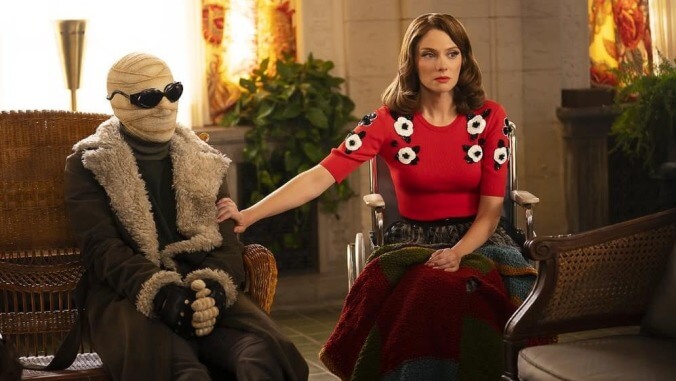The wildest thing about Doom Patrol is how it carries on the work of Norman Lear

In terms of television series, Doom Patrol is pretty out there. Based on a DC Comics property (specifically, the late-1980s iteration written by Grant Morrison), the show revolves around outcasts and weirdos of the superhero universe, people who see themselves not as superior beings, but unlucky souls cursed with powers that bring them hardship and sadness.
There’s Larry “Negative Man” Trainor (Matt Bomer), a former test pilot stuck with a being of pure energy in his body, one he can’t communicate with and that renders him helpless when it emerges. Cliff “Robotman” Steele (Brendan Fraser) is the brain of an auto racer welded into an outdated metal body following the accident that killed his wife and daughter. Rita “Elasti-Girl” Farr (April Bowlby) was a film star, forced into hiding after developing an uncontrollable power that turns her body into a sagging, gooey mass of flesh. Rounding out the main quartet is Crazy Jane (Diane Guerrero), a woman suffering from dissociative identity disorder who has 64 different personas, each with their own unique superpower. With aid from Cyborg (yes, the character from Justice League, here re-envisioned as a young man terrified of being taken over by his cybernetic parts), these broken and bruised individuals exist outside the comic book norm.
The show’s recently concluded first season (now streaming on DC Universe) was a postmodern mashup that never found a plotline or character too gonzo to employ, no emotion so sincere it can’t be mined for scatological comedy, no image too goofy to become integral to the plot. Whether it’s a farting donkey that hides a dimension inside itself or a cockroach with Curtis Armstrong’s voice who pops up periodically to rant about the end of days, the series prides itself on an unabashed embrace of its over-the-top source material. It all raises the obvious question: “How do you make that a coherent TV show?” Imagine my surprise when the series accomplished this tall order by following one of the sturdiest blueprints in TV history: the humanistic, progressive work of Norman Lear.
It’s an odd comparison, I’ll grant. Lear is a true icon of the medium, a pioneering and revolutionizing force whose résumé teems with some of the most admired and influential sitcoms ever made: All In The Family, Maude, The Jeffersons, Good Times, One Day At A Time, Sanford & Son. Doom Patrol is a superhero show with a recurring character who tracks people by eating bits of their hair. American television has absorbed the DNA of Lear’s output so deeply that his latter-day influence is difficult to quantify. It’s rare to find scripted comedies that aren’t indebted to him, even when it’s not explicit. But what makes Doom Patrol’s Lear parallels interesting is all the ways the show seems to rebut his shows’ structures and aesthetic while subtly embracing their spirit. So let’s look at what these canonical shows have in common with an obscure bunch of DC also-rans swearing up a storm on a niche streaming service.
The storytelling is painfully intimate
My colleague Noel Murray has compared Lear’s work to the social realist theater of the early 20th century, and it’s not hard to see why. Shows like The Jeffersons and Maude are small-scale stories of working people dealing with culture clash, class consciousness, and changing social norms and mores that render life both more difficult and more bearable, depending on the day. It’s intimate, and sometimes harsh. It’s tempered by the “comedy” part of these situation comedies, but there’s challenging stuff at the heart of Lear’s endeavors, an effort to confront America with the uglier sides of itself.
For all the seeming pyrotechnics and CGI-aided chaos, Doom Patrol remains an uncomfortably close and personal affair. Its narrative resides as much in the flashbacks and memories of its traumatized protagonists as in their present. Any one installment is likely to devote attention to a painful encounter from the past, such as Larry’s heartbreaking lie of a marriage, a desperate attempt to keep his homosexuality secret amid the hypocritical optimism of the “Greatest Generation.” Here, there are striking parallels to the Lear oeuvre: The episode “Therapy Patrol,” in which the characters reflect on their interpersonal relationships and whether or not they should move forward together or apart, would make an excellent double bill with Maude’s first-season episode “Flashback,” in which Maude and husband Walter reminisce about their earlier years, and confront the decision about whether to get married, cohabitate, or just split up. Both showcase the messy relationship struggles that define our closest connections, and forego the normal theatrics of their respective genres for close-knit stories that defy easy classification.
Both confront hot-button social issues while avoiding soapbox moralizing or “very special episode” treacle
Lear’s shows never felt like homework, but it’s not because there weren’t profoundly serious issues being dealt with most of the time. Grappling with thorny questions of racism, classism, oppression, and generational culture-clash were par for the course on his sitcoms. From instances like The Jeffersons’ exploration of guns in America in season eight’s “A Case Of Self-Defense,” to All In The Family’s near-weekly calling out of mainstream racism, the social concerns of the time were always front and center in these programs. In a close look at the Sanford And Son episode “The Piano Movers,” we see the messages weren’t openly stated as “what have we learned?”-style lectures, but baked into the plotting and performances. Lamont Sanford repeatedly gets caught by a white employer finding him at rest during expected periods of work, while his father, Fred, the actual would-be slacker, is seen as being exploited by his lazy son. The reasons for the uncomfortableness of the predicament—racial, class-based, and generational—become fodder for humor and character beats, not PSAs. Similarly, season one’s “The Suitcase Case” finds the pair forced into (eventually) doing the right thing when they find a briefcase filled with stolen cash, the slow acceptance of the ethical decision mined for comedic pathos, given their financial straits.







































